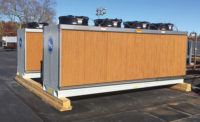The Cedar Rapids Community School District’s (CRCSD) ongoing mission to update antiquated buildings with energy-efficient HVAC equipment is expected to save taxpayers millions of dollars in long-term energy savings while also providing optimal learning environments with exceptional air comfort.
The state-of-the-art HVAC design by consulting architecture/engineering firm Shive-Hattery, headquartered in Cedar Rapids, Iowa, utilized geothermal technology facilitated by water-source heat pumps, energy-recovery outdoor air equipment, and fabric ductwork in larger spaces.
Besides energy savings, the design also brings air conditioning and ASHRAE Standard 62.1 outdoor air compliance to the CRCSD’s older schools. By replacing the existing conventional hot water boiler-supported, two-pipe unit ventilators, the retrofitted schools have recorded utility bill savings. School officials report the payback in energy savings is expected to occur in less than eight years for the district’s older buildings that now have air conditioning.
REMEMBERING ROOSEVELT
The design was first implemented in the HVAC retrofit of Roosevelt Middle School 15 years ago. The successful design was later used in HVAC in five other middle schools, including retrofit projects at Truman and Hiawatha Elementary Schools, Kennedy High School, Jefferson High School, and, most recently, last year at Washington High School.
Washington’s results are still being tabulated; however, earlier geothermal school retrofits have provided 30-40 percent more efficiency than the systems they replaced, according to Tim Fehr, mechanical engineer, Shive-Hattery, which designs HVAC retrofit and new systems for dozens of Midwestern school buildings. “To the credit and vision of the oversight committee, they looked at our research data and long-term savings estimates 16 years ago — at a time when two- or four-pipe unit ventilators supplied by air-cooled chillers and boilers were the standard for schools — and progressively made the commitment to use geothermal on every future school HVAC retrofit project,” said Fehr.
Truman’s original geothermal concept remains state-of-the-art today, although Shive-Hattery does tweak the design when new innovations were introduced on the market. For example, Truman’s open architectural ceiling areas used fabric duct manufactured by DuctSox, which was very progressive in 2000. Fabric duct reduces ventilation material/installation costs and fast-tracks installation time to assure work completion during a short two-month summer recess. Shive-Hattery specifies fabric duct more frequently today, but now incorporates innovations, such as linear L-vents for indoor air comfort, custom colors to match school colors, in-duct tensioning systems for 24/7 inflated aesthetic appearance, and other improvements.
Washington’s HVAC retrofit was designed by Shive Hattery’s Gail Loeffler, mechanical designer, and Fehr. It was installed by Universal Climate Control, Coralville, Iowa, and is CRCSD’s most cutting-edge version thus far. Washington was outfitted with a 1,600-gallon per minute (gpm) open-loop geothermal system finished in 2015, which includes state-of-the-art production and injection capabilities. The geothermal systems supply individual classroom water-source heat pumps, manufactured by Florida Heat Pump (FHP), a division of Bosch Thermotechnology Corp., and integral heat pumps in 14 packaged heat recovery units. The packaged units, manufactured by Venmar CES, a Nortek Air Solutions brand, condition outdoor air and recirculate indoor air. Other geothermal loop equipment includes 128 water-to-air FHP heat pumps comprised of EP, LV, and EC Series, ranging from up to 16 EER to 21.1 EER.
Washington features another design tweak that incorporates inline-straight or elbow metal duct silencers to attenuate mechanical noise since most heat pumps have short duct runs and are located close to classrooms.
“The silencer is a safeguard that guarantees a quiet learning environment and reduces mechanical noise by 20 dB, which far surpasses the ANSI S12.60 [classroom acoustics] standard,” said Fehr, who added that Shive-Hattery will also begin specifying newly introduced silencers by the textile duct industry on fabric duct runs used in upcoming projects.
Washington’s design uses fabric duct most innovatively with a custom Washington Warrior red color to match school colors; linear L-vents for draft-less air distribution; and a SkeleCore Internal Hoop System (IHS), which maintains an inflated appearance, even when the air handler is off. Keeping an inflated appearance and eliminating the distraction and noise of rollouts during air-handler startup was a game-changer and encouraged more fabric duct use than the past retrofitted buildings, according to Rob Kleinsmith, buildings and grounds manager, CRCSD.
Curt Rogers, ventilation products project manager at Rist & Associates, a Des Moines, Iowa-based manufacturer’s representative, oversaw Washington’s fabric duct facilitation; the installation of grilles, registers, and diffusers manufactured by Price Industries; and the implementation of exhaust fans built by Loren Cook Co.
Fabric is also an adequate retrofit choice, because double-wall insulated round metal duct is 85 percent heavier for contractors to handle, typically requires painting or coatings, and can be labor intensive to connect seams or tightly thread through bar joists of open architectural ceilings, according to Fehr.
While metal duct is difficult to remove and is expensive to outsource for cleaning in place, CRCSD’s in-house staff has a periodic schedule of cleaning fabric duct runs to provide optimal IAQ, which requires approximately a half-day to disassemble, commercially launder, and reassemble.
Another important factor in the CRCSD’s post-retrofits energy efficiency is the building automation system, which incorporates front-end software manufactured by Tridium Inc., an independent business entity of Honeywell Intl. Inc., and controls by Johnson Controls Inc. and Andover Continuum, a division of Schneider Electric. The CRCSD also went the extra mile with the schools’ control systems, realizing that extensive monitoring and control points create routines and programs that optimize total energy efficiency, according to Fehr.
Information courtesy of John Parris-Frantz on behalf of DuctSox. Contact him at 773-871-2600 or john@jpfcomm.com.
PUTTING THE COOL IN SCHOOL
Cedar Rapids Community School District's (CRCSD) Washington High School utilizes a great deal of fabric ductwork. The four largest spaces using fabric duct include:
- The district’s natatorium, which is a 9,300-square-foot building that includes 240 linear feet of 36-inch-diameter Verona fabric duct in a perimeter configuration with IHS;
- The 5,000-square-foot wood shop offers 160 linear feet of Tuftex fabric duct via multiple runs ranging 10-18 inches in diameter, which is supplied by a fabric header;
- The big gym, a 15,000-square-foot space, offers 480 linear feet of 26-inch-diameter TufTex fabric duct with IHS in four straight runs; and
- The 10,000-square-foot small gym utilized 280 linear feet of 26-inch-diameter Tuftex fabric duct with IHS.
Publication date: 1/30/2017
Want more HVAC industry news and information? Join The NEWS on Facebook, Twitter, and LinkedIn today!








